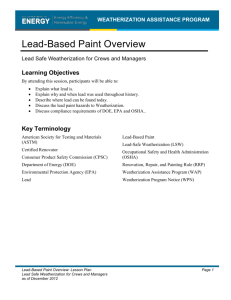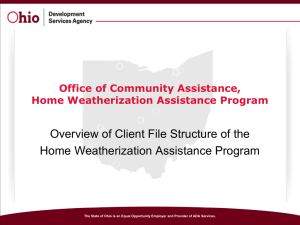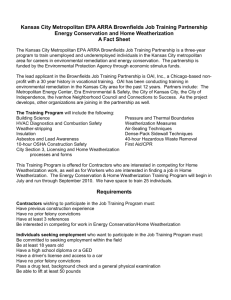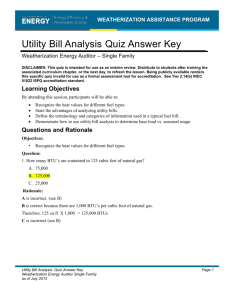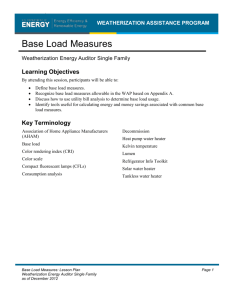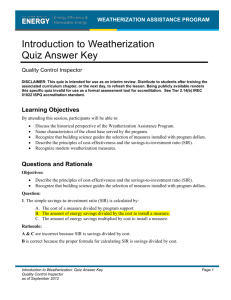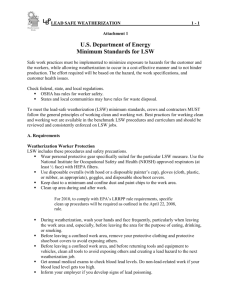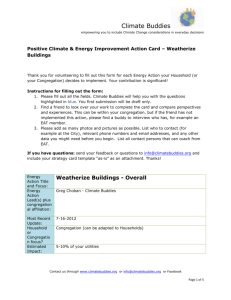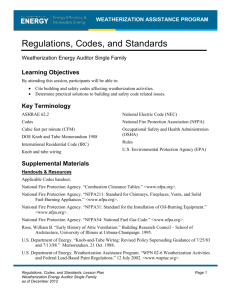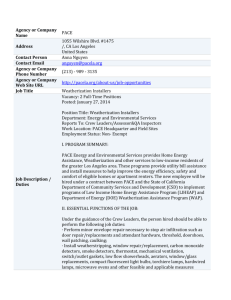Lead Safe Weatherization Elements
advertisement
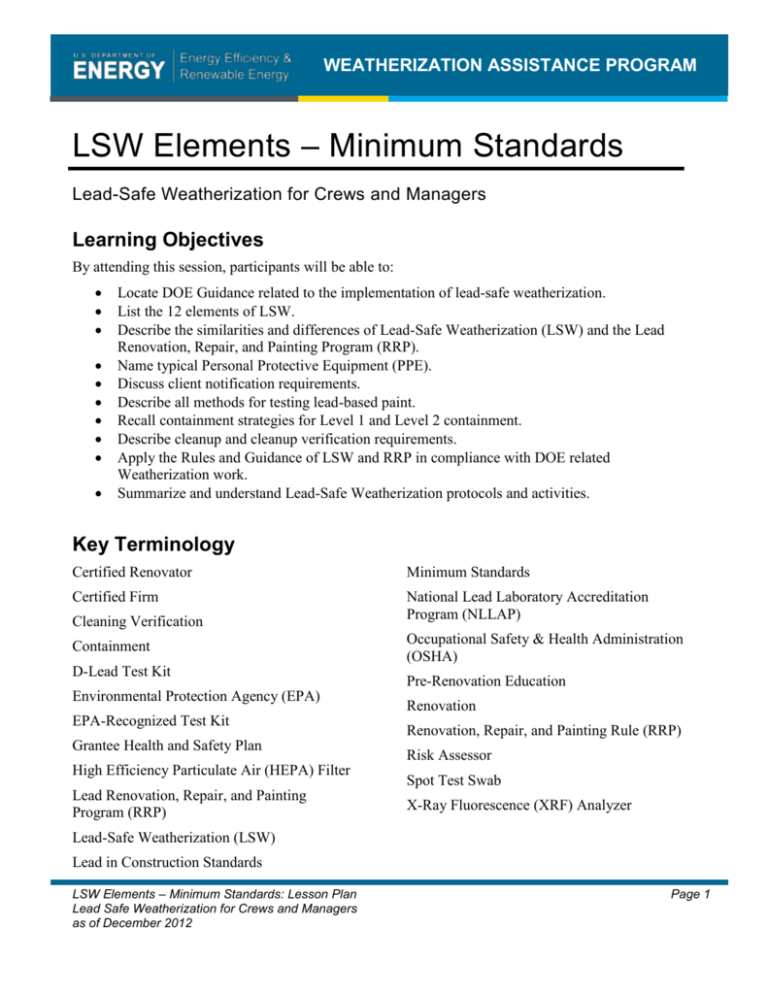
WEATHERIZATION ASSISTANCE PROGRAM LSW Elements – Minimum Standards Lead-Safe Weatherization for Crews and Managers Learning Objectives By attending this session, participants will be able to: Locate DOE Guidance related to the implementation of lead-safe weatherization. List the 12 elements of LSW. Describe the similarities and differences of Lead-Safe Weatherization (LSW) and the Lead Renovation, Repair, and Painting Program (RRP). Name typical Personal Protective Equipment (PPE). Discuss client notification requirements. Describe all methods for testing lead-based paint. Recall containment strategies for Level 1 and Level 2 containment. Describe cleanup and cleanup verification requirements. Apply the Rules and Guidance of LSW and RRP in compliance with DOE related Weatherization work. Summarize and understand Lead-Safe Weatherization protocols and activities. Key Terminology Certified Renovator Minimum Standards Certified Firm National Lead Laboratory Accreditation Program (NLLAP) Cleaning Verification Containment D-Lead Test Kit Environmental Protection Agency (EPA) EPA-Recognized Test Kit Grantee Health and Safety Plan High Efficiency Particulate Air (HEPA) Filter Lead Renovation, Repair, and Painting Program (RRP) Occupational Safety & Health Administration (OSHA) Pre-Renovation Education Renovation Renovation, Repair, and Painting Rule (RRP) Risk Assessor Spot Test Swab X-Ray Fluorescence (XRF) Analyzer Lead-Safe Weatherization (LSW) Lead in Construction Standards LSW Elements – Minimum Standards: Lesson Plan Lead Safe Weatherization for Crews and Managers as of December 2012 Page 1 WEATHERIZATION ASSISTANCE PROGRAM Supplemental Materials Handouts & Resources “12 Steps to Lead Safety.” WxTV. Montana Weatherization Training Center. <wxtvonline.org>. Lead-Safe Weatherization (LSW) Lesson 3: LSW Elements: Minimum Standards Workbook/Instructor Manual. Dec. 2012 OSHA. “Lead in Construction Standards 1926.62.” <www.osha.gov/Publications/osha3142.pdf.> OSHA. “Respiratory Protection Program Rules.” <www.osha.gov/SLTC/respiratoryprotection/index.html.> US Department of Energy. Weatherization Assistance Program. “WPN 02-6: Weatherization Activities and Federal Lead-Based Paint Regulations.” 12 July 2002. <www.waptac.org.> US Department of Energy. Weatherization Assistance Program. “WPN 02-6: Weatherization Activities and Federal Lead-Based Paint Regulations. Attachment B: Lead Paint Decision Chart.” 12 July 2002. <www.waptac.org.> US Department of Energy. Weatherization Assistance Program. “WPN 08-6: Lead Guidance Program Notice.” 22 September 2008. <www.waptac.org.> US Department of Energy. Weatherization Assistance Program. “WPN 09-6: Lead Safe Weatherization (LSW) – Additional Materials and Information.” 22 January 2009. <www.waptac.org.> US Department of Energy. Weatherization Assistance Program. “WPN 11-6: Health and Safety Guidance.” 12 January 2011. <www.waptac.org.> US Department of Housing and Urban Development. “HUD Guidelines for the Evaluation and Control of Lead-Based Paint Hazards in Housing.” 1 October 1996. http://portal.hud.gov. U.S. Environmental Protection Agency. “Lead – Frequent Questions” <http://epa.gov/lead/pubs/renovation.htm>. or 1-800-424-LEAD (5323) U.S. Environmental Protection Agency. “Lead Renovation, Repair and Painting Program Rules” <http://www.epa.gov/lead/rrp-reg.html>. U.S. Environmental Protection Agency. “The Lead-Safe Certified Guide to Renovate Right” <http://www.epa.gov/lead/pubs/renovaterightbrochure.pdf>. Sept. 2011. On-line Platform Lessons Use these on-line interactive training modules as prerequisites before students attend the course or as in-class computer lab sessions. Users must first create an account at www.nterlearning.org to access. LSW Elements – Minimum Standards: Lesson Plan Lead Safe Weatherization for Crews and Managers as of December 2012 Page 2 WEATHERIZATION ASSISTANCE PROGRAM Relevant Standards Work Specifications – Single Family 1.100.1 – Global Worker Safety 3.1201.1 – Double-hung Wood Windows 3.1201.2 – Single-unit Window and Fixed Frame with Wood Sash 3.1201.3 – Exterior Doors 3.1202.1 – Fixed Frame with Wood Sash – Older House 3.1202.2 – Single-unit Window, Mounted on Rough Opening – Newer House 3.1203.1 - Fixed Frame with Wood Sash – Older House 3.1203.2 – Single-unit Window, Mounted on Rough Opening – Newer House Classroom Props & Activities Have various EPA-approved lead paint testing tools on hand to display including: Swab tests. D-Lead test kit. X-Ray Fluorescence instrument, if available. Exercise: When is Level 2 containment required? Tape measure. Painter’s tape or masking tape. When you get to the part of the presentation that discusses Level 2 containment, ask volunteers from the class to indicate what they think is 6 ft2 and 20 ft2 respectively. These are the minimum standards for level 2 containment. Using a tape measure and tape, mark off those areas in a couple of configurations to show how the area might be disturbed. o For example, 6 ft2 might be a 2x3 ft rectangle if creating attic access or, a series of 4x4 inch holes (if installing dense-pack sidewall insulation from the interior). 20 ft2 might be 4 strips that are just ½ inch wide but 10 ft long from removing siding for an exterior blow. Level 1 vs. Level 2 Containment – Select an area of the classroom, training center, or actual home if doing an on-site training, and have students prepare the area as if LSW below 6 sq. ft. is being conducted (interior) or less than 20 sq. ft. (exterior). Provide all necessary plastic sheeting, tape, and other tools. After this, assume that more area is going to be disturbed and containment must be upgraded to Level 2. Have students bring the area to the increased level of containment by installing vertical containment as necessary (interior). Cleanup – After the containment exercise, provide the necessary vacuums and wet-cleaning materials, LSW Elements – Minimum Standards: Lesson Plan Lead Safe Weatherization for Crews and Managers as of December 2012 Page 3 WEATHERIZATION ASSISTANCE PROGRAM garbage bags, and duct tape and have students follow the steps of LSW cleanup. Ensure that they follow protocols including the treatment of their coveralls, other PPE, and tools to avoid contamination of the work area, work truck, or other spaces with lead dust. Class Overview This lesson is designed to be completed in 4 hours, including around 90 minutes for the presentation with the rest of the time spent on hands-on skill sets. This time estimate may vary depending upon the amount of optional supplemental material, demonstrations, etc. that are incorporated into the presentation. Page 4 Use the presentation and discussion to teach students the general concepts and structure of DOE’s Lead-Safe Weatherization protocol. Use videos and hands-on examples to get students comfortable with the steps required in LSW and the documentation and verification requirements of RRP. Explain and demonstrate Lead-Safe Weatherization protocols and activities including lead testing, containment levels, cleanup, verification, and documentation. Review the 12 steps of LSW: o Worker training. o Pre-1978 lead testing or assuming presence of lead. o Client notification – “Pre-Renovation education.” o Barriers and signage/Restricting access. o Containment. o Personal Protective Equipment (PPE)/Respiratory protection. o Safe work practices/Tools. o Work-site cleanup. o Work-site visual inspection. o Cleaning verification. o Debris disposal. o Documentation. LSW Elements – Minimum Standards: Lesson Plan Lead Safe Weatherization for Crews and Managers as of December 2012
